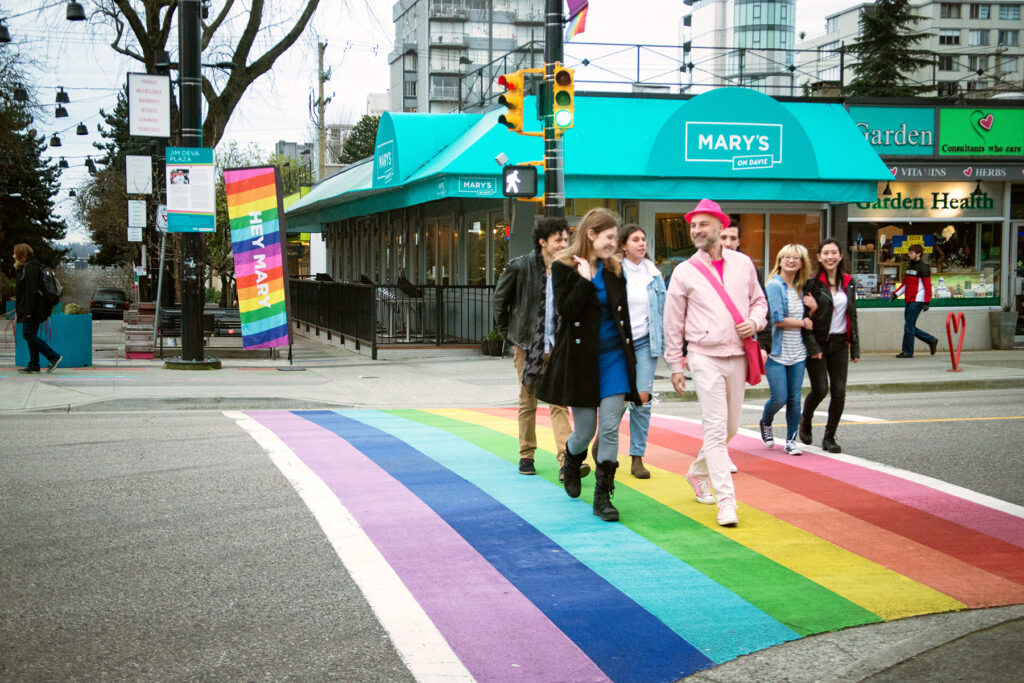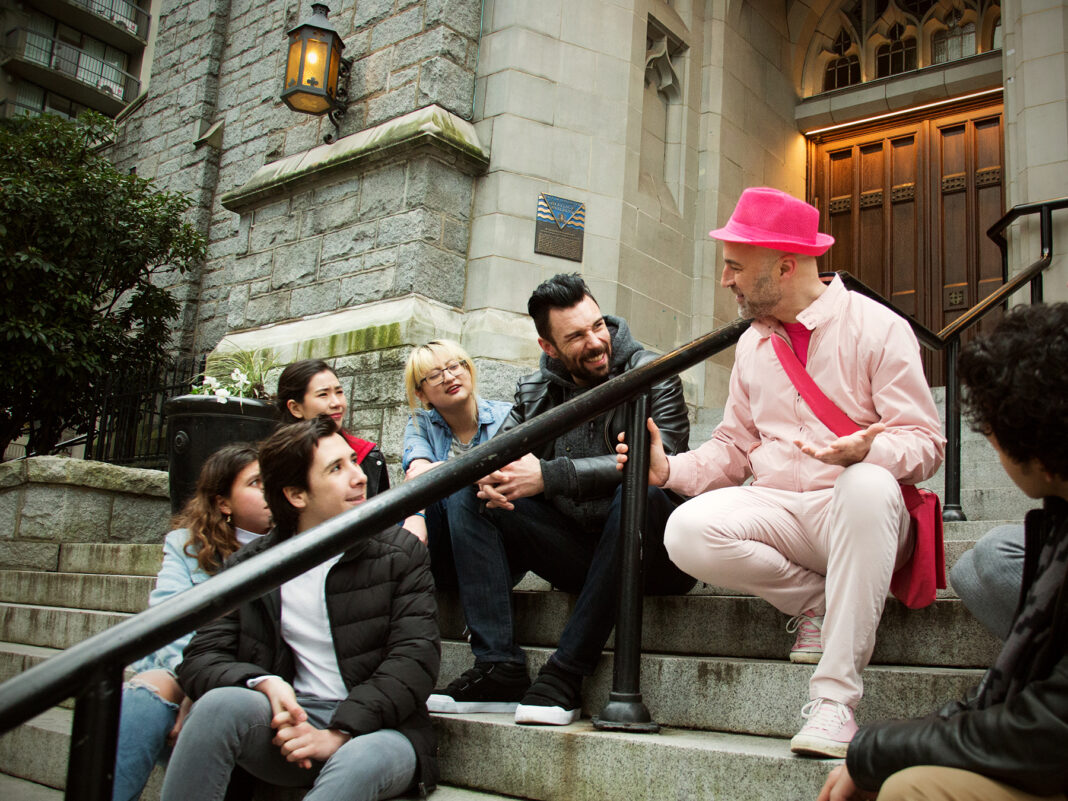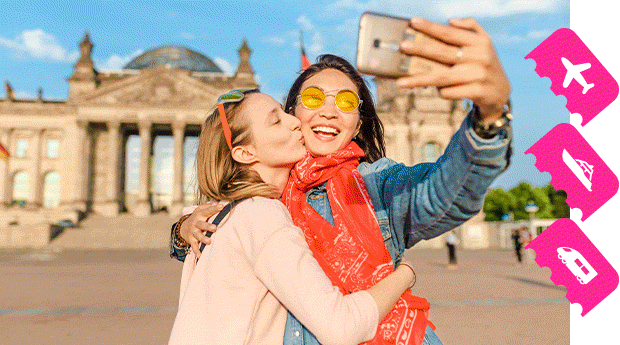In so many places around the world, queer history is hidden out of sight. A visitor might be wandering in locations where joyous or traumatic events have happened and not even know it.
Vancouver storyteller Glenn Tkach was working as a guide with Forbidden Vancouver Walking Tours, which focuses on prohibition-era history—rum runners, mobsters and crooks—when he had an idea for a “really gay history” tour that would surface many of the stories from his home city’s LGBTQ2S+ past. So much of Vancouver has been taken over by big, shiny buildings, little remains of what was there before. After almost a year of research, digging through archives and interviewing historians and people who themselves made history, he launched the tour of Vancouver’s Davie Street Village, affectionately referred to as the gaybourhood.
The weekly tour (private tours are available) attracts curious locals and visitors, queers and straights, the old and the young. Many groups are shocked by the injustices that earlier generations of LGBTQ2S+ people suffered through. “These are stories about suppression and persecution, about brave heroes who have paved the way for us,” says Tkach. “I’ve realized that for the most part, our community doesn’t know about it, and we don’t even know how much we don’t know about our champions and role models.”
Tkach’s two-hour tour is full of fascinating well-researched stories that have made Vancouver the LGBTQ2S+-friendly destination it is today. We asked him to give us a small taste of what he shares with his tour groups.
A historical monument where you can shop
Little Sister’s Book & Art Emporium (1-1238 Davie St., Vancouver). This queer bookstore now occupies a roomy street-level space right off the gaybourhood’s main drag—it’s a great place to buy souvenirs and support local writers and artists. But Tkach takes visitors to the original address, founded in 1983 on the second floor of an old house on nearby Thurlow Street. Though the site is now a parking garage, it’s where Little Sister’s founders Bruce Smyth and Jim Deva, and manager Janine Fuller, waged much of their legal battle against the Canada Border Services Agency. For decades, the government agency targeted the books, magazines and videos imported by the store, seizing and censoring LGBTQ2S+ material. A true David and Goliath story, the case was heard by the Supreme Court of Canada, and in 2000, the court sided with Little Sister’s, declaring that the government had violated the freedom of expression and equality rights of the store and its customers. “What people are less aware of is how that played out and the nature of the persecution that they faced. It wasn’t just a legal battle. There were also terrorist attacks on the bookstore, by which I mean the bookstore was bombed. It really demonstrated the ferocity of the prejudice and persecution against our community at that time,” says Tkach.
A nearby pedestrian-only block of the gaybourhood, Jim Deva Plaza, is named after one of the leaders in the crusade against censorship. Deva died in 2014.
A historical monument where you can have a smart cocktail
Fairmont Hotel Vancouver (900 W. Georgia St., Vancouver). One of Canada’s grandest railway hotels when it opened in 1939, Hotel Vancouver quickly became a haunt for men who were into men. “There used to be a bar on the basement level that’s no longer there, a fancy hotel bar. Going back to the 1940s, it was a clandestine hookup spot for gay men. It was not a modern-day gay bar by any stretch of the imagination. Even inside the bar, you had to keep it on the down-low. But gay men knew they could go there to make connections with each other in coded ways,” says Tkach.
These days the hotel is a very LGBTQ2S+-friendly Fairmont property with two cool resto-bars, Botanist Bar and Notch8. Flirt there and be your authentic self as openly as you’d like.
Historical monuments you can touch
Well, you can touch them if you’re tall enough. The West End of Vancouver started to become a gay place to live as early as the 1930s, when the Great Depression changed the character of the area from one filled with mansions to one filled with apartment buildings. The many laneways in the area remained unnamed until the 2010s, when the city and the local business improvement association started naming them in honour of people from traditionally underrepresented groups, including women, people of colour, queer activists and HIV/AIDS activists. “Obviously, they have a practical purpose. They’re there to name a street and help people find their way, but they’re also there to commemorate and honour these heroes.”
ted northe Lane is named for a drag queen and gay civil rights activist who died in 2014, while Jepson-Young Lane is named for Peter Jepson-Young, a doctor who promoted HIV/AIDS awareness in TV spots called the Dr. Peter Diaries. He died in 1992.
A historic monument that’s a whole neighbourhood
While gay men tended to live in the West End, in the 1970s, queer women, who were more economically marginalized, started moving to the working-class neighbourhood of Grandview-Woodland. Located in the east, it’s better known by the name of its main street, Commercial Drive.
“While the West End has more apartment buildings, in the East End, the houses have not been subdivided. That means they form communal houses, renting as groups of women. While gay men had the money to go to bars, to commercial spaces, the lesbians built community spaces in their homes through living together, backyard barbecues, dinner parties, that kind of thing,” says Tkach. “Lots of cities have gay villages like the West End, but not as many have evolved this kind of village for lesbians. Vancouver is unique in having done so.”
A historic monument you can walk on

One of the most uplifting chapters of Vancouver’s LGBTQ2S+ history is a recent one: the unveiling of rainbow crosswalks at the corner of Davie and Bute streets. Painted in 2013, they were the first permanent rainbow crosswalks in Canada, and were repainted in 2016 with the opening of Jim Deva Plaza. They gave the community visibility and a sense of stewardship over the busy downtown neighbourhood. “It’s a lovely place to be able to finish the tour, as kind of an emblem of where we are right now in our history, to look at these crosswalks and see how loudly and visibly they proclaim our presence,” says Tkach.
Tkach’s tours can be booked through the Forbidden Vancouver website.


